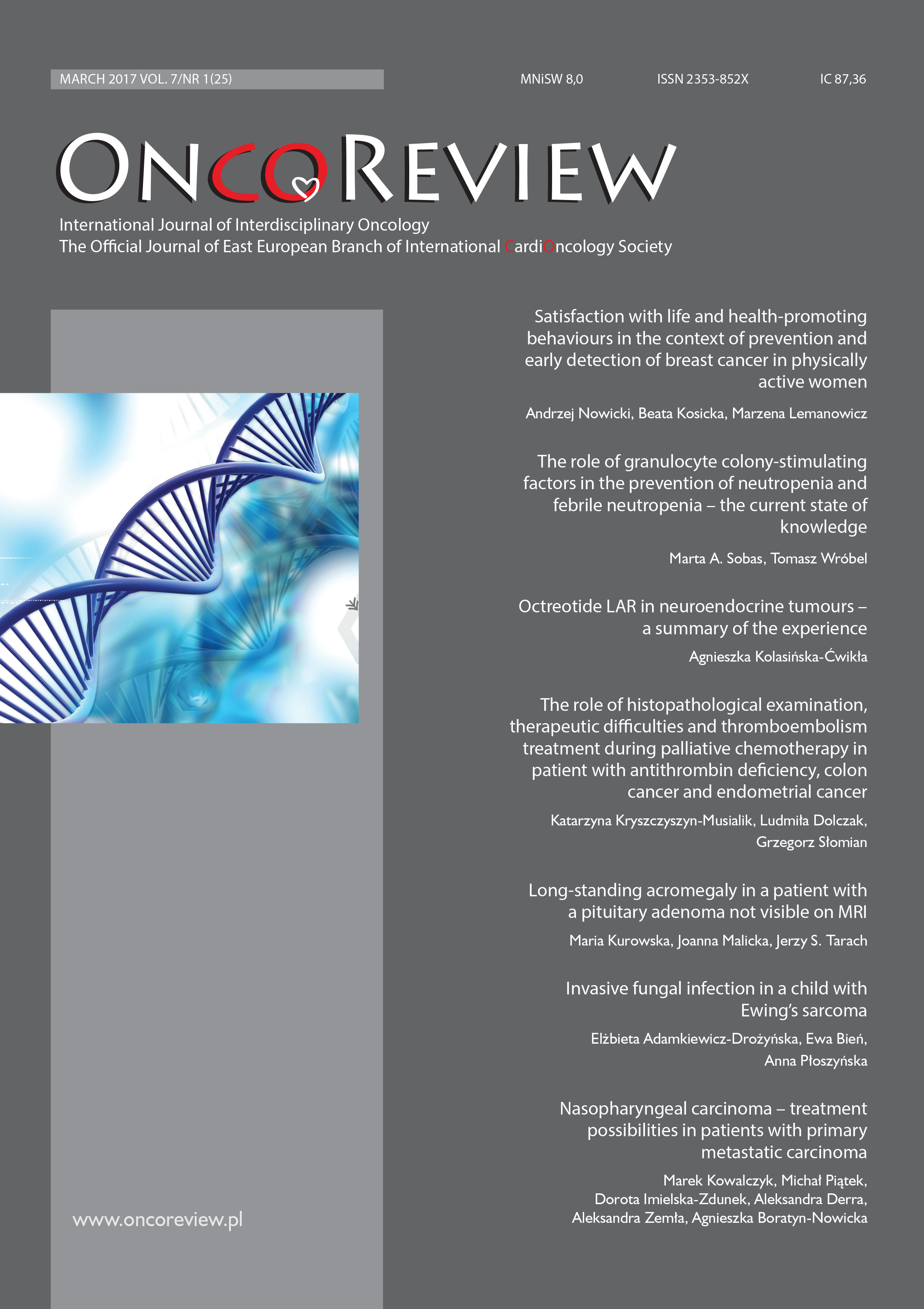Octreotide LAR in neuroendocrine tumours – a summary of the experience Review article
Main Article Content
Abstract
Neuroendocrine tumours are a rare and heterogeneous group of neoplasms. Most of the patients are diagnosed with locally advanced or metastatic disease and curative surgery is rarely an option. Somatostatin analogues have been shown to control the symptoms and growth of well-differentiated metastatic neuroendocrine tumours. Octreotide LAR is one of the treatment options.
Downloads
Metrics
Article Details

This work is licensed under a Creative Commons Attribution-NonCommercial 4.0 International License.
Copyright: © Medical Education sp. z o.o. This is an Open Access article distributed under the terms of the Attribution-NonCommercial 4.0 International (CC BY-NC 4.0). License (https://creativecommons.org/licenses/by-nc/4.0/), allowing third parties to copy and redistribute the material in any medium or format and to remix, transform, and build upon the material, provided the original work is properly cited and states its license.
Address reprint requests to: Medical Education, Marcin Kuźma (marcin.kuzma@mededu.pl)
References
2. Yao JC, Hassan M, Phan A et al. One hundred years after “carcinoid”: epidemiology of and prognostic factors for neuroendocrine tumors in 35,825 cases in the United States. J Clin Oncol 2008; 26: 3063-3072.
3. Öberg K, Knigge U, Kwekkebom D et al.; On behalf of the ESMO guidelines working group. Neuroendocrine gastro-entero-pancreatic tumors: ESMO clinical practice guidelines for diagnosis,treatment and follow-up. Ann Oncol 2012; 23: 124-130.
4. Öberg K. Neuroendocrine gastrointestinal tumors – a condensed overview of diagnosis and treatment. Ann Oncol 1999; 10: S3-S8.
5. Baldelli R, Barnabei A, Rizza L et al. Somatostatin analogs therapy in gastroenteropancreatic neuroendocrine tumors: current aspects and new perspectives. Front Endocrinol (Lausanne) 2014;5: 7. https://doi.org/10.3389/fendo.2014.00007.
6. Reubi JC, Waser B, Schaer JC et al. Somatostatin receptor sst1--sst5 expression in normal and neoplastic human tissues using receptor autoradiography with subtype – selective ligands. Eur J Nucl Med 2001; 28:836-846.
7. Reubi JC, Mengod G, Palacios JM et al. Somatostatin receptors in human cancer: incidence, characteristics, functional correlates and clinical implications. J Steroid Biochem Mol Biol 1992; 43(1-3): 27-35.
8. Öberg K. Established clinical use of octreotide and lanreotide in oncology. Chemotherapy 2001; 47: 40-53.
9. Oberg K. Future aspects of somatostatin-receptor-mediated therapy. Neuroendocrinology 2004; 80: 57-61.
10. Oberg K, Kvols L, Caplin M. Consensus report on the use of somatostatin analogs for the management of neuroendocrine tumors of the gastroenteropancreatic system. Ann Oncol 2004; 15: 966-973.
11. Schally AV. Oncological applications of somatostatin analogues. Cancer Res 1988; 48: 6977-6985.
12. Scarpignato C, Pelosini I. Somatostatin analogs for cancer treatment and diagnosis: an overview. Chemotherapy 2001; 47: 1-29.
13. Weckbecker G, Raulf F, Stolz B, Bruns C. Somatostatin analogs for diagnosis and treatment of cancer. Pharmacol Ther 1993; 60: 245-264.
14. Schally AV, Nagy A. Chemotherapy targeted to cancers through tumoral hormone receptors. Trends Endocrinol Metab 2004; 15: 300-310.
15. Rinke A, Müller HH, Schade-Brittinger C et al. Placebo-controlled, double-blind, prospective, randomized study on the effect of octreotide LAR in the control of tumor growth in patients with metastatic neuroendocrine midgut tumors: a report from the PROMID Study Group. J Clin Oncol 2009; 27(28): 4656-4663.
16. Caplin ME, Pavel M, Ćwikła JB et al. Lanreotide in metastatic enteropancreatic neuroendocrine tumors. CLARINET. N Engl J Med 2014; 371(3): 224-233
17. Pyronnet S, Bousquet C, Najib S et al. Antitumor effects of somatostatin. Mol Cell Endocrinol 2008; 286: 230-237.
18. Reubi JC. A somatostatin analogue inhibits chondrosarcoma and insulinoma tumour growth. Acta Endocrinol (Copenh.) 1985; 109: 108-114.
19. Pollak MN, Schally AV. Mechanisms of antineoplastic action of somatostatin analogs. Proc Soc Exp Biol Med 1998; 217: 143-152.
20. Imam H, Eriksson B, Lukinius A. Induction of apoptosis in neuroendocrine tumors of the digestive system during treatment with somatostatin analogs. Acta Oncol 1997; 36: 607-614.
21. Eriksson B, Renstrup J, Imam H et al. High-dose treatment with lanreotide of patients with advanced neuroendocrine gastrointestinal tumors: clinical and biological effects. Ann Oncol 1997; 8 :1041-1044.
22. Arena S, Pattarozzi A, Corsaro A et al. Somatostatin receptor subtype-dependent regulation of nitric oxide release: involvement of different intracellular pathways. Mol Endocrinol 2005; 19, 255-267.
23. Bousquet C, Puente E, Buscail L et al. Antiproliferative effect of somatostatin and analogs. Chemotherapy 2001; 47: 30-39.
24. Rinke A, Wittenberg M, Schade-Brittinger C et al. Placebo-Controlled, Double-Blind, Prospective, Randomized Study on the Effect of Octreotide LAR in the Control of Tumor Growth in Patients with Metastatic Neuroendocrine Midgut Tumors (PROMID): Results of Long-Term Survival. Neuroendocrinology 2017; 104(1): 26-32.
25. Jann H, Denecke T, Koch M et al. Impact of octreotide long-acting release on tumour growth control as a first line treatment in neuroendocrine tumours of pancreatic origin. Neuroendocrinology 2013; 98(2): 137-143.
26. Marconcini R, Ricci S, Vasile E et al. Efficacy of Somatostatine Analogs (SSA) in Gastroenteropancreatic Neuroendocrine Tumors (GEP-NET) according to ki67 index. J Clin Oncol 2014; 32(5 suppl.): abstr. 1145.
27. Toumpanakis Ch, Laskaratos F, Maragkoudakis E et al. Antiproliferative activity of octreotide LAR in advanced neuroendocrine tumors. J Clin Oncol 2014; 32(5 suppl.): abstr. 4110.
28. Strosberg JR, Yao JC, Bajetta E et al. Efficacy of octreotide long-acting repeatable in neuroendocrine tumors: RADIANT-2 placebo arm post hoc analysis. Endocr Relat Cancer. 2015; 22(6):933-40.

